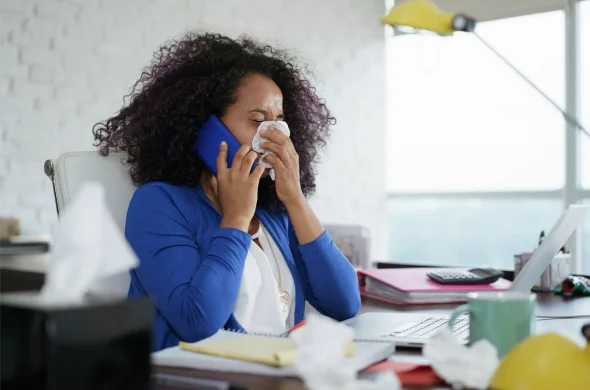That dreaded tickle in your throat or the onset of body aches can feel like a personal betrayal, especially when it derails your workout routine. The question immediately arises: to sweat or not to sweat? The desire to push through is understandable, but your body’s needs must come first.
The answer to whether Exercising While Sick is safe isn’t a simple yes or no. It’s a nuanced decision that depends entirely on your symptoms. Let’s navigate this together, with practical advice to help you decide what’s best for your body.
The “Neck Rule”: Your Quick Guide to Exercising While Sick
A helpful rule of thumb used by many health professionals is the “neck check.” It’s a simple way to gauge whether light activity might be okay or if rest is non-negotiable.
- Symptoms ABOVE the neck? (GO, but take it easy)
- What this includes: A runny nose, nasal congestion, sneezing, or a minor sore throat.
- The verdict: Light to moderate exercise is generally considered safe. Think of a brisk walk, a gentle bike ride, or a restorative yoga session. Listen to your body and reduce your intensity and duration.
- Symptoms BELOW the neck? (STOP, and rest)
- What this includes: Chest congestion, a hacking cough, stomach upset, body aches, fever, chills, or fatigue.
- The verdict: This is your body’s clear signal to rest. Exercising While Sick with these symptoms can hinder recovery, lead to dehydration, and even worsen your illness. A fever, in particular, is a major red flag, as exercise can raise your body temperature further.
The Potential Benefits of Light Movement
When your symptoms are mild and above the neck, gentle movement can actually be beneficial. Light exercise can:
- Boost circulation: This may help your immune cells move through your body more effectively.
- Open nasal passages: A brisk walk can sometimes provide temporary relief from congestion.
- Improve mood: Being active can release endorphins, helping to combat the lethargy and frustration that often accompanies a cold.
Crucial Precautions for Exercising While Sick
If you’ve passed the “neck check” and decide to proceed, follow these golden rules:
- Listen to Your Body: This is the most important rule. If you feel worse during your workout, stop immediately. Your body is using its energy to heal.
- Hydrate, Hydrate, Hydrate: Drink plenty of water, herbal tea, or broth. Fever, sweating, and mucus production all increase your fluid needs.
- Scale It Way Back: Now is not the time for high-intensity interval training (HIIT) or attempting a personal best. A light activity is enough.
- Stay Home: Be considerate of others. Avoid the gym to prevent spreading your germs. Opt for a home workout or an outdoor walk instead.
- Prioritize Sleep: Sleep is the most powerful recovery tool you have. Don’t sacrifice sleep for a workout.
What to Do After You’ve Exercised While Sick
Your post-workout routine is just as important. Help your body recover by:
- Continuing to hydrate with water and electrolytes if needed.
- Fueling with nutrient-rich foods like soups, fruits, and vegetables.
- Allowing for extra rest. Your body is fighting an infection and repairing from exercise—it needs downtime.
The Bottom Line: Listen to the Expert, Your Body
Exercising While Sick is a personal judgment call, but the safest approach is always to err on the side of caution. Pushing through severe symptoms can set your recovery back by days or even lead to more serious complications.
Remember, a few days of rest is not a setback in your fitness journey; it’s an investment in your long-term health. Your gym will be there when you’ve fully recovered, stronger and ready to return. When in doubt, choose rest and consult with a healthcare professional for guidance.
Disclaimer: This article is for informational purposes only and does not constitute medical advice. Always consult with your doctor or a healthcare professional for personalized recommendations, especially if you have underlying health conditions.
